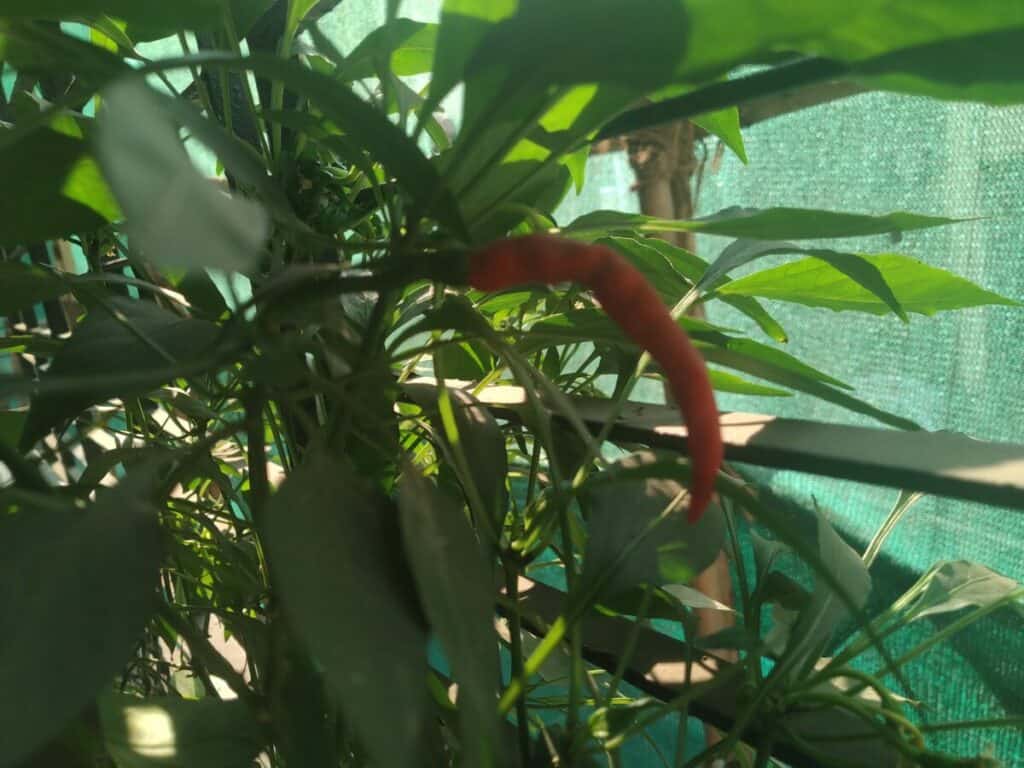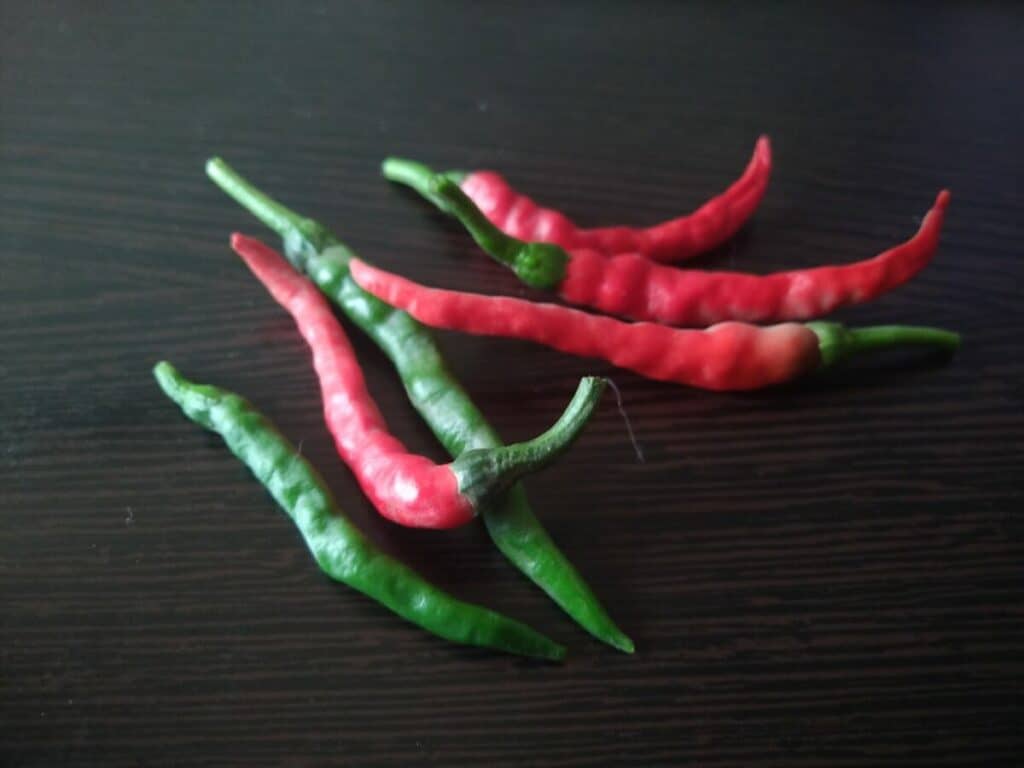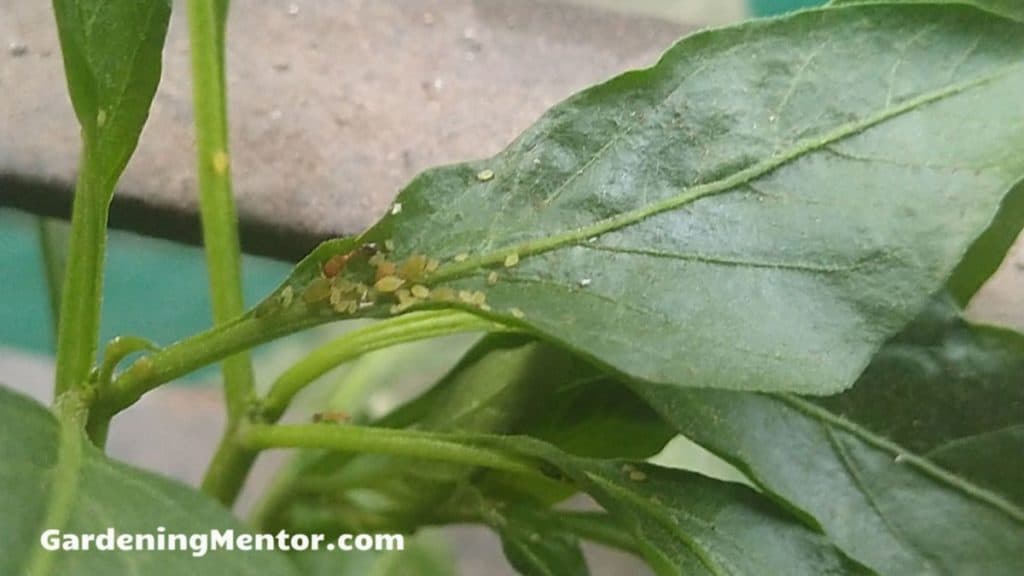Are you ready to spice up your victory garden? There are hundreds of varieties of hot peppers (capsicum), with options ranging from zero to 16,000,000 on the infamous Scoville Heat Unit Scale.
When you’re growing hot peppers, choosing a variety is half the fun. For this article, we aimed to provide helpful growing tips for a wide range of hot peppers plants. Keep in mind that these colorful fruits have more than capsaicin to offer.
What are Hot Peppers?
Hot peppers represent a spectrum of capsaicin-enriched nightshades that are grown all over the world. Used mainly for culinary and medical purposes, hot peppers are some of the most widely distributed fruits in the grocery industry. These incredibly sought after nightshades fall into the capsicum genus.
Since hot peppers bring such a wide variety of heat, a pharmacologist invented a rating system to better identify their intensity. This is the Scoville Rating System. It’s still used today. With so many hot-sauce and hot-pepper aficionados, hot pepper plants are becoming a backyard garden favorite.
What are the Different Varieties Available?
Let’s talk about a few of the more popular hot pepper varieties. Keep in mind that there are thousands more to discover. The pepper plants listed below are just some of the ones you’re more likely to find in your local nursery.
Cayenne
Cayenne peppers are horn-shaped red or green peppers. They are super easy to grow and exceptionally ornamental. They can be used to flavor oils, sauces, and more.
Thai Chili Pepper
Thai chili peppers are small and spindly. These little red peppers produce plenty of heat. The plants are small and bushy, rising no more than 18 inches. These make great potted plants, as they are considered ornamental.
Jalapenos
Jalapeno pepper plants are excellent options for beginners. After all, there are so many fun ways to process your excess yields. Pickled peppers, anyone?
Habanero
Habanero is another small and spicy pepper variety. These plants are quite decorative. They can grow to be well over 5 feet tall. These little peppers add a big punch to recipes.
Scotch Bonnet
Scotch bonnet peppers are a popular flavor agent is many classic Caribbean dishes. They’re sweet and spicy. Despite their tropical origin, they grow well in USDA hardiness zones two through 12.
Carolina Reaper
Carolina Reapers are the hottest peppers on record. They’ve earned a Scoville rating well over 1,500,000. You wouldn’t know how dangerous they are by looking at them. They’re petite, cherry-red, and wrinkly. Plants can grow as high as 5 feet.
Anaheim Chili Pepper
Anaheim chili peppers are one of the more mild hot pepper varieties. These plants take as many as 80 days to mature. Once they start producing fruit, they will continue to do so for several weeks.
When is the Best Time to Plant?
Sow your pepper seeds in small containers. Do this up to 10 weeks before the last predicted frost in your area. It takes peppers several weeks to germinate.
Hot pepper seedling should only be transplanted when they have strong roots and there has not been a recorded frost for two to three weeks.
Where Can You Plant Hot Peppers?
If you live in a temperate (or four-season) climate, you may be shocked to hear that hot pepper plants are perennials. Most gardeners treat these high-yield plants as annuals. Nevertheless, under ideal conditions, hot pepper plants are capable of producing fruit for several years.
Climate
Hot pepper plants thrive in temperatures that range between 65- and 80-degrees Fahrenheit. Extended cool periods can lead to the demise of otherwise healthy pepper plants. The growing windows for hot pepper plants vary, but most need at least three months to reach full maturity. These sensitive warm-weather staples cannot survive a frost.
Soil
Like most plants, hot peppers can benefit from being planted in optimized soil. According to the Umass Agricultural Extension, hot pepper plants thrive in fertile, well-drained soil. They recommend planting hot peppers in sandy loam with high organic matter.
The ideal soil acidity for pepper plants is between 6.5 and 6.8 pH. If you are unsure of your soil’s acidity, submit a sample to your local agricultural extension for analysis. You can lower the acidity of soil by applying agricultural lime. Whenever possible, apply the alkalinity-boosting amendment before winter.
Hot pepper plants require nitrogen, phosphorus, and potassium to grow. The results of a simple backyard soil test will tell you if your soil is lacking essential plant nutrients. You can use natural or synthetic fertilizers to boost the health of your hot pepper plants.
We recommend that you apply a basic 10-10-10 fertilizer before and during the growing window. Most experts recommend doing this right when the fruits start to appear.
Sunlight
Hot pepper plants fare well in direct sunlight. However, most plants do well when planted in succession with other pepper plants or other nightshades. Consecutive rows serve to create some protective shade. Most peppers require 6 to 8 hours of direct sunlight each day.
Keep in mind that the southern side of your yard is going to receive the most direct sunlight if you live in the northern hemisphere. Naturally, the opposite can be said for the southern hemisphere.

Water
Hot pepper plants respond well to frequent yet controlled applications of water. Most plants need no more than an inch of water per week. Water can be applied in one to two applications when rainfall is not sufficient. Soil should be allowed to dry out thoroughly between watering sessions.
If you are an inexperienced grower, it may take some time for you to adapt to a supplemental watering schedule. Precipitation constantly fluctuates throughout the growing season. You can avoid common watering mistakes by regularly checking the moisture level in your soil.
Tip: If you’re growing your hot pepper plant in a pot, consider watering the nightshade from the bottom. Keep in mind that hot pepper plants should only ever be planted in containers with drainage holes. If you’re keeping your plants inside, remember that you are their only source of hydration.
It’s quite easy to identify a parched pepper plant. Wilted leaves and slouching stems and shoots are sure-fire signs that your pepper plant is thirsty. Remember, irrigation is all about adapting. Stay tuned t
How to Plant Hot Peppers in Your Garden
Hot peppers can be sowed directly from seed, but most first-time growers usually have more success with nursery-raised seedlings. In temperature climates, plants should be incubated indoors until they are at least 8 weeks old. You can also purchase seedlings at most local nurseries and home improvement stores.
Wait a few weeks past the last predicted frost before placing your hot pepper plants directly in the ground. The Farmer’s Almanac does a great job of calculating the average date of the last spring frost in hardiness zones throughout North America. You can enter your postal zip code into their online search to get the most accurate frost date prediction in your area.
Choose a sunny area in your yard or garden beds for your new pepper plants. According to Mary’s Heirloom Seeds, growers don’t need to pick out an isolated space for their Scoville-ranking bumper crops.
If you’re sowing a small yet diverse selection of plants, rest easy knowing that hot peppers have plenty of potential companions. We won’t bother listing them all here, but some of our favorites include beans, chards, squash, and tomatoes.
This never-ending list of suitable plant pairings reminds us that, for heat-seeking eaters, hot peppers are a welcome flavor agent for nearly any vegetable dish. As such, we recommend you plan your garden with consumption in mind.
Most hot pepper varieties need to be planted 18 to 24 inches apart. Rows should be spaced 2 to 3 feet apart. Hot pepper plants vary in size and diameter, but many can grow to be several feet in height with quite sizable leaf covers.
How to Care for Hot Peppers
Watering
As hot climate crops, hot peppers still require some supplementary irrigation. As we mentioned above, you can get away with watering your pepper plants just one to two times each week.
Most growers say that these resilient warm-weather crops thrive when their shallow root systems are allowed to dry thoroughly between waterings sessions. Pay close attention to your plants during flowering and fruiting.
Tip: Excess water can cause rots to succumb to bacteria and mold.
Transplanting
If you seeded your pepper plants inside or purchased seedlings at your local nursery, you’ll need to transplant them to bigger pots, raised beds, or rows when they’re ready.
Experts agree that hot pepper plants should be allowed to develop well-defined white roots before transplant. If young plants are left in small containers, the roots become twisted and bound. Rootbound plants do not transplant well.
If you’re transferring your seedlings to larger containers, place an inch of potting soil at the base of the new container. If you’re planting them in the ground, take the time to till the earth. Then, dig a hole large enough to accommodate the pepper seedling’s root base. Gently tilt the seedling upside down and slide off the container.
Use your fingers to gently loosen the roots. Place the young plant in its new cultivation location. Fill the container with remaining soil. Pat the surface of the soil down to ensure that the roots are properly supported. Water the freshly transplanted seedling promptly after transferring.
Tip: If you live in a temperate climate and have started your hot pepper plants in a climate-controlled indoor area, it’s a good idea to harden them off before transferring them to an outdoor garden.
According to the Farmer’s Almanac, hardening off is the process of slowly acclimating indoor-grown plants to the outdoors. Some growers take a period of one to two weeks to slowly increase the time their seedlings spend outside. Hot pepper plants are less likely to succumb to cold shock after going through a brief hardening off process.
Many gardeners also prefer to transplant seedlings on slightly overcast days. Milder weather and less direct sunlight ensure that plants do not succumb to heat shock. Of course, always wait at least two weeks from the last predicted frost of the season before planting. Peppers cannot be exposed to temperatures less than 50-degrees Fahrenheit.
Fertilizing

Most growers have success when they feed their hot pepper plants a basic 1-2-2 mixture of slow-release N-P-K (nitrogen, phosphorus, potassium) fertilizer. A nutrient-rich organic compost is also a great addition to any soil mixture. Keep in mind that some organic fertilizers do not contain all three essential nutrients.
Most expert gardeners feed their hot peppers three times during the growing season, including a pre-planting application, a second application during flower, and a third application during fruiting.
We advise gardeners to get their soil tested before selecting a fertilizer. The nutrient content of your soil should have a direct impact on your amendment selections.
Weeding
Help your hot pepper plants thrive by removing the competition. Hot pepper plants have shallow and somewhat fragile root systems. As such, you must remove weeds while they are young. You’d be impressed by how quick rogue plants will rob your young pepper plants of water and nutrients.
Mulching
Many growers like to layer a thin layer of organic mulch or straw (never use hay) around their pepper plants. This helps the soil retain moisture while simultaneously fending off fast-growing weeds. Keep your mulch layers thin to ensure that air and water can circulate properly.
How to Harvest and Store Hot Peppers
You’ve worked hard all season, and you now have enough peppers to supply an entire army with heartburn. What do you do with all that excess? We’ve got tips and tricks for harvesting and storing hot peppers.
Harvest
Harvest times for hot peppers vary between varieties. For the most part, you can expect your hot pepper plants to reach peak maturity in less than 100 days.
Your peppers are ready to harvest when they’ve achieved their ideal size and color. Use a pair of sharp, sanitized scissors or gardening shears to cut ripe peppers from their host plant.
Tip: Be careful not to tug on the step, as you could weaken the entire plant. Not all peppers mature at the same rate. So, expect to return to the same plant multiple times during the harvest season.

Storage
Be sure to enjoy some of your peppers while they are fresh. Freshly harvested pepper will stay fresh for two weeks to a month when stored in a refrigerator set around 40 degrees Fahrenheit. Remove any dead or damaged peppers from the bunch. Brush off dirt. Then place your fresh, dry whole peppers in sealed plastic bags.
Excess peppers can be dried, roasted, canned, or frozen. You can even use your crop of hot peppers to create a stockpile of hot sauce, salsa, and other condiments. Hot peppers serve as the backbone for so many dishes. Many people even prefer the taste and texture of preserved peppers over the fresh ones.
Keep in mind that most hot peppers contain a lot of capsaicin. This is a chemical that is responsible for all that heat. When peppers are broken open, the oils are easily spread through contact. As Sean Evans, the host of Hot Ones, often reminds his guests, you’re going to want to keep your hands away from your face when handling anything with capsaicin in it.
Tip: Wait to wash your fruit. While many growers are eager to rinse their freshly plucked fruits, moisture is a magnet of bacteria and fungi. You can extend the life of your hot peppers by waiting to wash them. Wash your peppers only when you plan to consume them.
What Pests and Diseases Affect Hot Pepper Plants?
Pests
Those tongue-numbing Scoville units don’t scare off pests. In this section, we discuss some of the most common hot pepper plant problems.
Aphids
Aphids are tiny insects that quickly spread from one host plant to another. They are often found clinging to the bottom of the leaves on hot pepper plants. In a short period, they will suck a massive amount of nutrients from a plant. In doing this, they often spread detrimental mold and fungi. Many growers use protective bumper crops and predatory insects to fend off aphids.

Pepper Hornworm
Hornworms are large milky green caterpillars that use hot pepper plants as a nursery for their young. Hornworm larvae are ferocious eaters. If left unnoticed, these young insects will kill your pepper plants by quickly consuming all its leaves.
Organic hornworm management techniques include the introduction of predatory insects, such as yellow jackets and ladybugs. If you only have a few pepper plants to manage, you can pluck the insects off one by one. Set them in a bowl of soapy water to ensure they cannot return.
Nematodes
Nematodes are small parasites that are known to infiltrate hot pepper plants. Nematodes are one of the harder pests to identify and mitigate because much of the damage they do is underground. If your hot pepper plants are wilting and turning yellow, nematodes may be the issue.
According to the University of Florida’s IFAS Extension, these pesky little insects spread infections to the roots of hot pepper plants. You can manage nematode infestations by rotating crops and leaving rows to follow. You can also steer clear of these little destroyers by opting for nematode-resistant hot pepper varieties.
Spider Mites
Much like aphids, spider mites are small enough to go undetected. These little insects feed off of their host plants. Wilted, discolored leaves and stunted plants are often a sign of a mite infestation. Management options include soap and water spray and chemical insecticides, though the latter should be the last option for most growers.
Diseases
Fusarium Wilt
Fusarium wilt is a fungal disease that wreaks havoc on its host plants. It turns leaves droopy, brittle, and discolored. Even survivor plants produce significantly fewer yields. Whenever possible, choose wilt-resistant hot pepper varieties. If you suspect your pepper plants are infected with these fungi, use sterile scissors or agricultural clippers to remove damaged leaves.
Bacterial Spot
We cannot tell you how many times we’ve observed plants with these unsightly yet common bacterial infections. Yellowish-brown leaf spots are a sign of bacterial spot. The unsightly brown legions can even spread to the surface of the fruit. These unsightly blemishes make for undesirable harvests.
Powdery Mildew
Powdery mildew is an unsightly fungal disease that spreads across the bottoms of hot pepper plant leaves. Outbreaks can occur at any time.
However, they are far more likely when the weather is humid. Avoid drenching your plants to avoid powdery mildew outbreaks. Remedies include applications of neem oil and other antifungal solutions.
Final Thoughts
If you enjoy hot peppers and want to grow them, the first step is to figure out which variety you want to grow. You can decide this based on how hot you like your peppers and the ones suitable for growing in your climate.
So get started growing those hot peppers and enjoy them as part of your favorite meals.

Fact Checked, Written, and Published by Kevin Rodrigues
Kevin is the founder of Gardening Mentor, a website that aims to teach people to grow their own food in a limited space. As a self-taught gardener, Kevin has spent several years growing plants and creating gardening content on the website. He is certified in Home Horticulture and Organic Gardening from Oregon State University. He has a Post Graduate Diploma in Horticulture and Landscape Gardening from Mumbai University.
Read more
